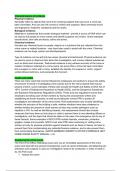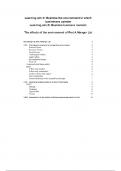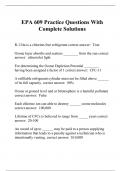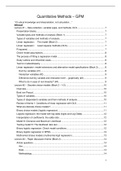Pearson
Edexcel
IAS
CHEMISTRY
WCH11/WCH12
, CONTENTS
Unit 1: Structure, Bonding and Introduction to Organic Chemistry
Unit 2: Energetics, Group Chemistry, Halogenoalkanes and Alcohols
,Unit 1: Structure, Bonding and Introduction
to Organic Chemistry
Topic 1: Formulae, Equations and Amount of Substance
a demonstrate an understanding of the terms atom, element, ion, molecule, compound,
empirical and molecular formulae
• An element is a substance that cannot be broken down by chemical means into other
substances.
• All the atoms in an element have the same atomic number which is the number of
protons in an atom.
• An atom is the smallest part of an element that can take part in a chemical change.
Atoms have no charge, they are neutral.
• The mass number of an atom is the sum of protons and neutrons in that atom.
• A compound is formed when two or more elements are chemically bonded together.
• A molecule is the smallest part of the covalent compound or element that can exist on
its own.
• Ionic compounds are formed from ions.
• An ion is formed when an atom gains or loses one or more electrons – ions are
therefore, charged particles.
b write balanced equations (full and ionic) for simple reactions, including the use of state
symbols
A balanced chemical equation tells us not only what is reacting and what is produced but also in
what proportions the atoms combine. A balanced chemical equation has the same number of
atoms on each side.
Example
Unbalanced Equation: H2 +O2 → H2O
Balanced equation: 2H2 + O2 → 2H2O
2
, c demonstrate an understanding of the terms relative atomic mass, amount of substance,
molar mass and parts per million (ppm), e.g. gases in the atmosphere, exhausts, water
pollution
• The relative atomic mass of an element is the average (weighted) mass of the element’s
isotopes relative to one – twelfth of the mass of a carbon – 12 atom.
• The mole is the unit of chemical amount or amount of substance.
• 1 mole is the amount of substance that contains as many particles as there are atoms in
exactly 12g of carbon – 12.
• The mass, in grams of 1 mole of substance is known as molar mass, Mr.
𝑚𝑎𝑠𝑠
• 𝑎𝑚𝑜𝑢𝑛𝑡 =
𝑀𝑟
• 𝑎𝑚𝑜𝑢𝑛𝑡 = 𝑣𝑜𝑙𝑢𝑚𝑒 𝑥 𝑐𝑜𝑛𝑐𝑒𝑛𝑡𝑟𝑎𝑡𝑖𝑜𝑛
• Small concentration can be expressed in parts per million, ppm.
𝑚𝑎𝑠𝑠 𝑜𝑓 𝑐𝑜𝑚𝑝𝑜𝑛𝑒𝑛𝑡
𝑝𝑝𝑚 = × 106
𝑚𝑎𝑠𝑠 𝑜𝑓 𝑠𝑜𝑙𝑢𝑡𝑖𝑜𝑛
Example: There is 2g of organophosphate pollution in 1.5 million grams of solution.
➢ 𝑝𝑝𝑚 = × 106
➢ 𝑝𝑝𝑚 = 1.3
d calculate the amount of substance in a solution of known concentration (excluding titration
calculations at this stage), e.g. use data from the concentrations of the various species in blood
samples to perform calculations in mol dm −3
Example
Solute Normal blood level
Creatinine (a waste product of muscle 60 -120 mmol dm-3
metabolism)
Urea (a waste product of protein metabolism) 3.5 – 6.5 mmol dm-3
Na+ (sodium ions) 135 – 145 mmol dm-3
K+ (potassium ions) 3.5 - 5.0 mmol dm-3
An average person has 5dm3 of blood. Using the table above, find the minimum mass of
sodium ions in the blood of an average person.
3










